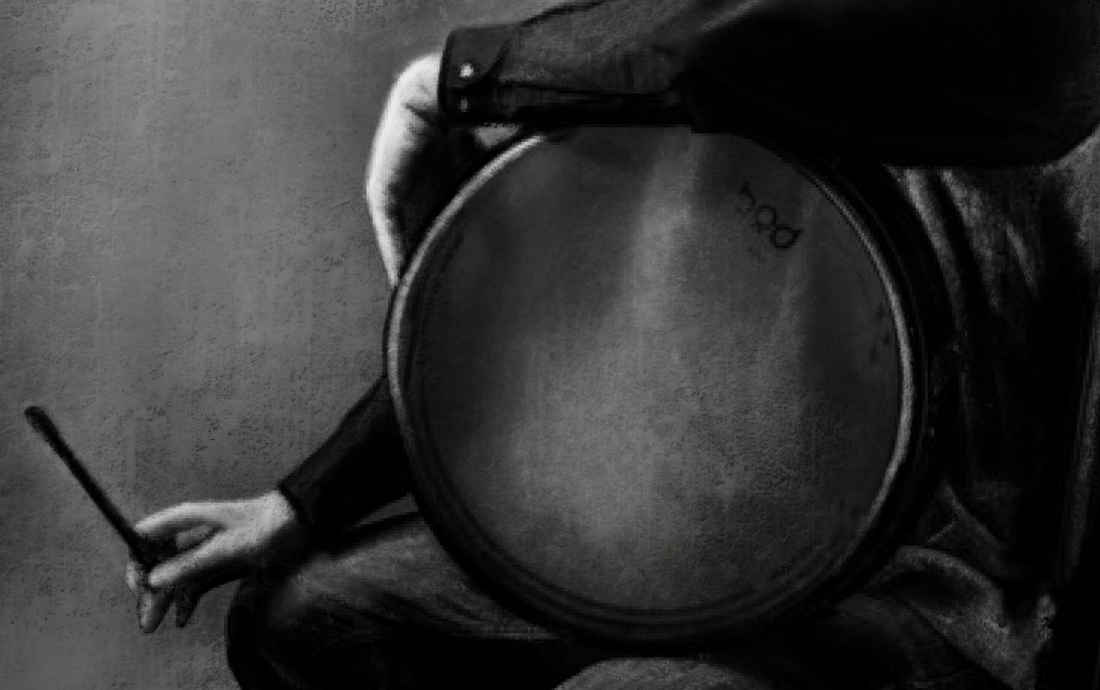The bodhrán is a single-headed Irish frame drum. It is usually about 18" in diameter, with a circular wooden frame and goatskin head. The inside of the frame is open, allowing for the placement of one hand against the skin of the drum to control pitch, timbre, and volume. In the hands of a skilled player, the bodhrán can imitate nearly every sound of a standard drum kit, and closely match the melody of a tune.
Much of the history of the bodhrán is the subject of speculation and debate, but some information can be gleaned from the meaning of the word itself. The name bodhrán is likely derived from the Gaelic word bodhar, meaning "deaf" and also bodharaighe, meaning "hollowness of sound" (read more on this here). The dh in the word is silent (since the mid-late Medieval period), and the word is pronounced bow-ran in English.
Frame drums have existed in various forms around the world since 3000 BCE, and likely before that. Similar instruments have been played by people in western Asia, south India, eastern Europe, north Africa, Iberia, Brazil, Tibet, Mongolia, and beyond. The most common iteration of this instrument in modern culture is the tambourine, and the bodhrán is comparatively simple in form, without the metal discs.
Many theories abound for how the bodhrán came to exist in Ireland. Some say it was used in farming as a tool for winnowing grain from chaff, and others suggest that it may have started as a tool for dying wool. It's possible also that it originated as a drum, used either by druids or bards. It is a handy instrument for accompanying song (see an example of this here)
Although it likely existed in Ireland prior to the 1700s, the bodhrán wasn't always the popular instrument in Irish music that it is today. There was a time when it was primarily played on Wren Day (Lá an Dreoilín) by Irish mummers, dressed in straw outfits. The bodhrán had a special place in this tradition, which likely was carried over from druidic times, in which the wren was considered a sacred bird, or "The King of All Birds" (read more on this here). Mícheál Ó Súilleabháin said that around 1970 or so, the common thinking was “you take out the bodhrán any day of the year other than 26 December and you’re mad. It’s like wearing shamrock on the first of June."
The bodhrán has grown in popularity since the 1960s, with the help of Seán Ó Riada, who included the instrument in his group Ceoltóirí Chualann. This group included many of the founding members of The Chieftains, including Peadar Mercier, who played the bodhrán using a cipín (tipper, beater, or stick). Prior to this, the bodhrán was mainly played using only the hands.
One of the most popular styles of playing the bodhrán today originated in Kerry, and involves using a two-headed cipín. In this style, the side of the stick closest to the player's chest is used to accompany the main rhythmic structure of the melody, while the end furthest from the chest may come in to play for the occasional ornamentation or roll. Many other styles exist, both for the placement of the hand on the back of the drum head (to modulate the pitch), as well as for playing with the cipín (with the hand at the top of the stick, or partway down). There are about as many ways to play bodhrán as there are bodhrán players.


1 comment
Hi
My name is John Nolan and I’m a bodhran player from Ireland…now living in Scotland. Having hurt my fingers before lock down I’m looking to ply again with a tipper made from a lighter material like balsa wood or cork which would be less injurous to finger joints. If you make them or know someone who could please let me know. I can pay you by PayPal. Regards… John Nolan